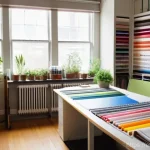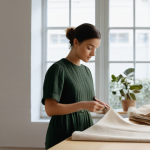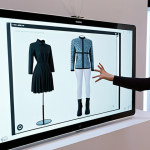So, you’re dreaming of breaking into the fashion design world? I remember when I first started, armed with a sketchbook and a whole lot of naive enthusiasm.
The industry can seem glamorous, but it’s also fiercely competitive and constantly evolving. To truly thrive, you’ll need more than just a flair for design; you’ll need grit, business savvy, and a knack for staying ahead of the curve.
It’s a wild ride, but incredibly rewarding if you’re willing to put in the work. Based on recent trends, sustainability and digital design skills are becoming increasingly crucial.
Let’s get right to the point and find out more in detail below.
## Developing an Unmistakable Design AestheticFashion design is not just about creating garments; it’s about crafting a signature. When you first enter the field, you are going to notice that everyone wants to know who you are, so what is your answer?
What do you want to show the world?
Understanding Your Design DNA

Dive deep into what truly excites you. What fabrics make your heart sing? What silhouettes do you find yourself sketching over and over again?
Are you drawn to avant-garde concepts or classic elegance? Identifying these core elements will form the foundation of your unique design identity. Start small.
A cohesive collection, even a mini one, speaks volumes more than a scattershot portfolio. Think about designers such as Iris Van Herpen and how she used 3D printing to revolutionize the field.
That is what a personal touch looks like.
Experimentation and Iteration
Don’t be afraid to push boundaries and challenge conventional norms. Play with unexpected materials, explore unconventional construction techniques, and let your imagination run wild.
The key is to experiment relentlessly and iterate based on the results. View every design as a learning opportunity. Don’t be afraid to start over, your first design will never be perfect but it will be yours.
Curating a Killer Portfolio
Your portfolio is your visual resume, so make sure it reflects your design aesthetic in the best possible light. Include a mix of sketches, illustrations, and finished garments, showcasing your range of skills and creativity.
Pay attention to the overall presentation, ensuring that your portfolio is well-organized, visually appealing, and easy to navigate. Remember, first impressions matter.
Mastering the Technical Skills
While creativity is essential, mastering the technical aspects of fashion design is equally important. Understanding pattern making, draping, sewing, and garment construction will allow you to bring your visions to life with precision and finesse.
Pattern Making and Draping
Pattern making is the art of creating templates for garments, while draping involves manipulating fabric on a dress form to create three-dimensional shapes.
These skills are fundamental to understanding garment construction and achieving accurate fit. Take a class, watch YouTube videos, or even find a mentor who can guide you through the process.
Sewing and Garment Construction
Sewing is the backbone of garment construction, and mastering this skill will enable you to execute your designs with confidence. Practice different sewing techniques, experiment with various fabrics, and pay attention to detail to achieve professional-quality finishes.
Digital Design Tools
In today’s digital age, proficiency in digital design tools is becoming increasingly essential for fashion designers. Software like Adobe Illustrator and Photoshop can be used to create technical drawings, renderings, and digital mockups, streamlining the design process and facilitating communication with manufacturers.
CLO3D, Browzwear, and similar tools help with 3D design and visualizing garment fit.
Navigating the Business Side of Fashion
Fashion design is not just about aesthetics; it’s also a business. Understanding the financial, marketing, and legal aspects of the industry will give you a competitive edge and increase your chances of success.
Fashion Industry Roles and Responsibilities
| Role | Responsibilities |
| ——————- | ——————————————————————————————————————————– |
| Fashion Designer | Conceives and creates clothing and accessory designs.
|
| Pattern Maker | Creates the technical patterns for garment production. |
| Sample Sewer | Sews prototypes or sample garments to test designs and patterns.
|
| Production Manager | Oversees the entire manufacturing process, ensuring quality and timely delivery. |
| Fashion Buyer | Selects and purchases merchandise for retail stores, considering trends and customer preferences.
|
| Visual Merchandiser | Creates eye-catching displays in retail stores to attract customers and promote sales. |
| Fashion Publicist | Manages a brand’s image and communication through media relations and events.
|
| Textile Designer | Creates designs for fabrics, including patterns, colors, and textures. |
Financial Management
Managing your finances wisely is crucial for the long-term sustainability of your fashion business. Create a budget, track your expenses, and explore funding options like loans, grants, or crowdfunding.
Understanding pricing strategies, profit margins, and cash flow will help you make informed decisions and avoid financial pitfalls.
Marketing and Branding
In a crowded marketplace, effective marketing and branding are essential for differentiating your brand and attracting customers. Develop a strong brand identity, create a compelling marketing strategy, and leverage social media to build a following and engage with your target audience.
Collaborate with influencers, participate in fashion events, and seek media coverage to increase brand visibility.
Building a Strong Network
The fashion industry is all about connections, and building a strong network can open doors to opportunities and collaborations.
Networking Events and Industry Organizations
Attend industry events, trade shows, and fashion weeks to meet potential mentors, collaborators, and clients. Join industry organizations like the Council of Fashion Designers of America (CFDA) or the British Fashion Council (BFC) to access resources, networking opportunities, and industry insights.
Mentorship and Collaboration
Seek out mentors who can provide guidance, support, and valuable insights based on their experience. Collaborate with other designers, photographers, stylists, and retailers to expand your reach and create unique projects.
Online Communities and Social Media
Engage in online communities and social media platforms to connect with fellow designers, share your work, and participate in discussions. Platforms like Instagram, LinkedIn, and fashion-specific forums can be valuable tools for building your network and staying up-to-date on industry trends.
Staying Ahead of the Curve
The fashion industry is constantly evolving, so it’s essential to stay informed, adaptable, and open to new ideas.
Trend Forecasting and Market Research
Stay abreast of the latest trends by following fashion publications, attending trend forecasting seminars, and conducting market research. Analyze consumer preferences, identify emerging niches, and adapt your designs to meet the evolving demands of the market.
Sustainability and Ethical Practices
Sustainability is no longer a trend; it’s a responsibility. Embrace eco-friendly materials, ethical production practices, and circular design principles to minimize your environmental impact and contribute to a more sustainable fashion industry.
Technology and Innovation
Embrace technology and innovation to enhance your design process, streamline your operations, and create unique products. Experiment with 3D printing, virtual reality, and wearable technology to push the boundaries of fashion design.
Cultivating Resilience and Perseverance
The path to success in fashion design is rarely smooth, so it’s essential to cultivate resilience and perseverance.
Overcoming Rejection and Setbacks
Rejection is a part of the creative process, so don’t take it personally. Learn from your mistakes, seek feedback, and use setbacks as opportunities for growth.
Maintaining Passion and Motivation
Stay connected to your passion by constantly seeking inspiration, exploring new ideas, and surrounding yourself with supportive people. Remember why you fell in love with fashion design in the first place, and let that passion fuel your creativity and drive.
Balancing Creativity and Business Realities
Balancing creativity with the business realities of the industry can be challenging, but it’s essential for long-term success. Learn to prioritize, manage your time effectively, and make informed decisions that align with your goals and values.
Developing an Unmistakable Design AestheticFashion design is not just about creating garments; it’s about crafting a signature. When you first enter the field, you are going to notice that everyone wants to know who you are, so what is your answer?
What do you want to show the world? I remember when I first started out, I felt like I was throwing spaghetti at the wall, hoping something would stick.
But after countless sketches, late nights, and a few fashion faux pas, I finally started to understand my design DNA.
Understanding Your Design DNA
Dive deep into what truly excites you. What fabrics make your heart sing? What silhouettes do you find yourself sketching over and over again?
Are you drawn to avant-garde concepts or classic elegance? Identifying these core elements will form the foundation of your unique design identity. Start small.
A cohesive collection, even a mini one, speaks volumes more than a scattershot portfolio. Think about designers such as Iris Van Herpen and how she used 3D printing to revolutionize the field.
That is what a personal touch looks like. I once spent an entire summer obsessed with vintage kimonos, and that fascination led to a collection of upcycled pieces that truly felt like “me.”
Experimentation and Iteration
Don’t be afraid to push boundaries and challenge conventional norms. Play with unexpected materials, explore unconventional construction techniques, and let your imagination run wild.
The key is to experiment relentlessly and iterate based on the results. View every design as a learning opportunity. Don’t be afraid to start over, your first design will never be perfect but it will be yours.
I’ve had designs that looked amazing in my head but were a total disaster in reality. But it’s those “failures” that teach you the most.
Curating a Killer Portfolio
Your portfolio is your visual resume, so make sure it reflects your design aesthetic in the best possible light. Include a mix of sketches, illustrations, and finished garments, showcasing your range of skills and creativity.
Pay attention to the overall presentation, ensuring that your portfolio is well-organized, visually appealing, and easy to navigate. Remember, first impressions matter.
I remember a design school professor telling me, “Your portfolio should tell a story, not just show off your skills.” That really stuck with me.
Mastering the Technical Skills
While creativity is essential, mastering the technical aspects of fashion design is equally important. Understanding pattern making, draping, sewing, and garment construction will allow you to bring your visions to life with precision and finesse.
Pattern Making and Draping
Pattern making is the art of creating templates for garments, while draping involves manipulating fabric on a dress form to create three-dimensional shapes.
These skills are fundamental to understanding garment construction and achieving accurate fit. Take a class, watch YouTube videos, or even find a mentor who can guide you through the process.
I struggled with pattern making at first, but once I started visualizing the patterns as 3D sculptures, it became much easier.
Sewing and Garment Construction
Sewing is the backbone of garment construction, and mastering this skill will enable you to execute your designs with confidence. Practice different sewing techniques, experiment with various fabrics, and pay attention to detail to achieve professional-quality finishes.
I’ve learned that a perfectly executed seam can make or break a garment.
Digital Design Tools
In today’s digital age, proficiency in digital design tools is becoming increasingly essential for fashion designers. Software like Adobe Illustrator and Photoshop can be used to create technical drawings, renderings, and digital mockups, streamlining the design process and facilitating communication with manufacturers.
CLO3D, Browzwear, and similar tools help with 3D design and visualizing garment fit. I use CLO3D to visualize my designs on virtual models before even cutting fabric – it saves so much time and resources!
Navigating the Business Side of Fashion
Fashion design is not just about aesthetics; it’s also a business. Understanding the financial, marketing, and legal aspects of the industry will give you a competitive edge and increase your chances of success.
Fashion Industry Roles and Responsibilities
| Role | Responsibilities |
| ——————- | ——————————————————————————————————————————– |
| Fashion Designer | Conceives and creates clothing and accessory designs.
|
| Pattern Maker | Creates the technical patterns for garment production. |
| Sample Sewer | Sews prototypes or sample garments to test designs and patterns.
|
| Production Manager | Oversees the entire manufacturing process, ensuring quality and timely delivery. |
| Fashion Buyer | Selects and purchases merchandise for retail stores, considering trends and customer preferences.
|
| Visual Merchandiser | Creates eye-catching displays in retail stores to attract customers and promote sales. |
| Fashion Publicist | Manages a brand’s image and communication through media relations and events.
|
| Textile Designer | Creates designs for fabrics, including patterns, colors, and textures. |
Financial Management
Managing your finances wisely is crucial for the long-term sustainability of your fashion business. Create a budget, track your expenses, and explore funding options like loans, grants, or crowdfunding.
Understanding pricing strategies, profit margins, and cash flow will help you make informed decisions and avoid financial pitfalls. I remember launching my first collection and completely underpricing my pieces.
It was a hard lesson in understanding the true cost of materials, labor, and marketing!
Marketing and Branding
In a crowded marketplace, effective marketing and branding are essential for differentiating your brand and attracting customers. Develop a strong brand identity, create a compelling marketing strategy, and leverage social media to build a following and engage with your target audience.
Collaborate with influencers, participate in fashion events, and seek media coverage to increase brand visibility. Social media is a game changer! I’ve built my brand almost entirely through Instagram, showcasing my process, inspirations, and connecting directly with my customers.
Building a Strong Network
The fashion industry is all about connections, and building a strong network can open doors to opportunities and collaborations.
Networking Events and Industry Organizations
Attend industry events, trade shows, and fashion weeks to meet potential mentors, collaborators, and clients. Join industry organizations like the Council of Fashion Designers of America (CFDA) or the British Fashion Council (BFC) to access resources, networking opportunities, and industry insights.
Don’t be afraid to approach people you admire at these events! I’ve landed some amazing collaborations simply by striking up a conversation.
Mentorship and Collaboration
Seek out mentors who can provide guidance, support, and valuable insights based on their experience. Collaborate with other designers, photographers, stylists, and retailers to expand your reach and create unique projects.
My mentor, a seasoned designer, has been invaluable in guiding me through the challenges of the industry.
Online Communities and Social Media
Engage in online communities and social media platforms to connect with fellow designers, share your work, and participate in discussions. Platforms like Instagram, LinkedIn, and fashion-specific forums can be valuable tools for building your network and staying up-to-date on industry trends.
I’ve found some of my closest collaborators through online design communities!
Staying Ahead of the Curve
The fashion industry is constantly evolving, so it’s essential to stay informed, adaptable, and open to new ideas.
Trend Forecasting and Market Research
Stay abreast of the latest trends by following fashion publications, attending trend forecasting seminars, and conducting market research. Analyze consumer preferences, identify emerging niches, and adapt your designs to meet the evolving demands of the market.
WGSN and other trend forecasting sites are my go-to for understanding upcoming trends and consumer behavior.
Sustainability and Ethical Practices
Sustainability is no longer a trend; it’s a responsibility. Embrace eco-friendly materials, ethical production practices, and circular design principles to minimize your environmental impact and contribute to a more sustainable fashion industry.
I’m committed to using only sustainable fabrics and working with ethical factories. It’s a challenge, but it’s worth it!
Technology and Innovation
Embrace technology and innovation to enhance your design process, streamline your operations, and create unique products. Experiment with 3D printing, virtual reality, and wearable technology to push the boundaries of fashion design.
The possibilities are endless! I’m currently experimenting with 3D-printed accessories – it’s like stepping into the future!
Cultivating Resilience and Perseverance
The path to success in fashion design is rarely smooth, so it’s essential to cultivate resilience and perseverance.
Overcoming Rejection and Setbacks
Rejection is a part of the creative process, so don’t take it personally. Learn from your mistakes, seek feedback, and use setbacks as opportunities for growth.
I’ve had collections that bombed completely. It stings, but you have to pick yourself up, dust yourself off, and keep creating.
Maintaining Passion and Motivation
Stay connected to your passion by constantly seeking inspiration, exploring new ideas, and surrounding yourself with supportive people. Remember why you fell in love with fashion design in the first place, and let that passion fuel your creativity and drive.
For me, it’s the joy of seeing someone wear something I created and feeling confident and beautiful.
Balancing Creativity and Business Realities
Balancing creativity with the business realities of the industry can be challenging, but it’s essential for long-term success. Learn to prioritize, manage your time effectively, and make informed decisions that align with your goals and values.
It’s a constant balancing act, but it’s what makes the journey so rewarding.
In Closing
So, whether you’re just starting out or already navigating the fashion landscape, remember that developing your design aesthetic, mastering technical skills, understanding the business side, building a strong network, and staying ahead of the curve are all crucial. Embrace the journey, stay true to your vision, and never stop creating. The fashion world awaits your unique perspective!
Useful Tips
1. Start a mood board – gather images, colors, textures that inspire you. It’s a great visual reference point.
2. Take advantage of free online courses – platforms like Skillshare and Coursera offer amazing fashion design courses.
3. Attend local fashion events – even small ones can provide valuable networking opportunities.
4. Follow industry leaders on social media – stay informed about trends, events, and insights.
5. Practice sketching regularly – even if you think you’re not good at it, consistent practice will improve your skills.
Key Takeaways
Focus on defining your unique design DNA through experimentation and self-discovery.
Master both creative and technical skills for comprehensive design capabilities.
Understand the business aspects of fashion to ensure sustainable growth.
Build a strong network through industry events and collaborations.
Embrace innovation, sustainability, and resilience to thrive in the ever-evolving fashion industry.
Frequently Asked Questions (FAQ) 📖
Q: What specific software programs are essential for a fashion design student to master these days?
A: Honestly, it’s not just about sketching on paper anymore. While traditional skills are vital, you need to be fluent in Adobe Creative Suite, especially Photoshop and Illustrator.
They’re like the bread and butter of digital design. I remember when I first started using Illustrator, I felt so clumsy, but trust me, practice makes perfect.
Also, look into Clo3D – it’s a game-changer for creating realistic 3D garment visualizations and is becoming increasingly popular in the industry. Mastering these programs not only makes your workflow more efficient but also opens doors to more job opportunities.
Q: Everyone talks about sustainability. But how can a student actually incorporate sustainable practices into their designs and projects?
A: That’s a great question, and it’s something I’m super passionate about! It’s not just a trend; it’s a necessity. As a student, start small.
Research sustainable fabrics – things like organic cotton, recycled materials, or even innovative options like mushroom leather (it’s wild, I know!). Challenge yourself to design with minimal waste – think zero-waste pattern cutting techniques.
Visit local thrift stores; you’d be amazed at the inspiration you can find in vintage clothing. Upcycling and redesigning existing garments is a fantastic way to practice your skills while being eco-conscious.
The key is to be mindful of the entire lifecycle of your garments, from sourcing to disposal.
Q: What’s the single most important piece of advice you would give to someone just starting their fashion design journey?
A: Develop thick skin, honey! The fashion industry is full of opinions, and not all of them will be kind. You’re going to face rejections, critiques, and moments of self-doubt.
Don’t let them define you. Learn to filter the noise and focus on your vision. But also, and this is super important, be open to feedback.
Constructive criticism can be invaluable. Find mentors, network with other designers, and always be willing to learn. Also, be prepared to work your tail off.
Success in fashion isn’t handed to you; it’s earned. I always tell myself “If it were easy, everyone would do it”. So, keep your passion burning, stay true to your unique style, and never give up on your dreams.
📚 References
Wikipedia Encyclopedia






